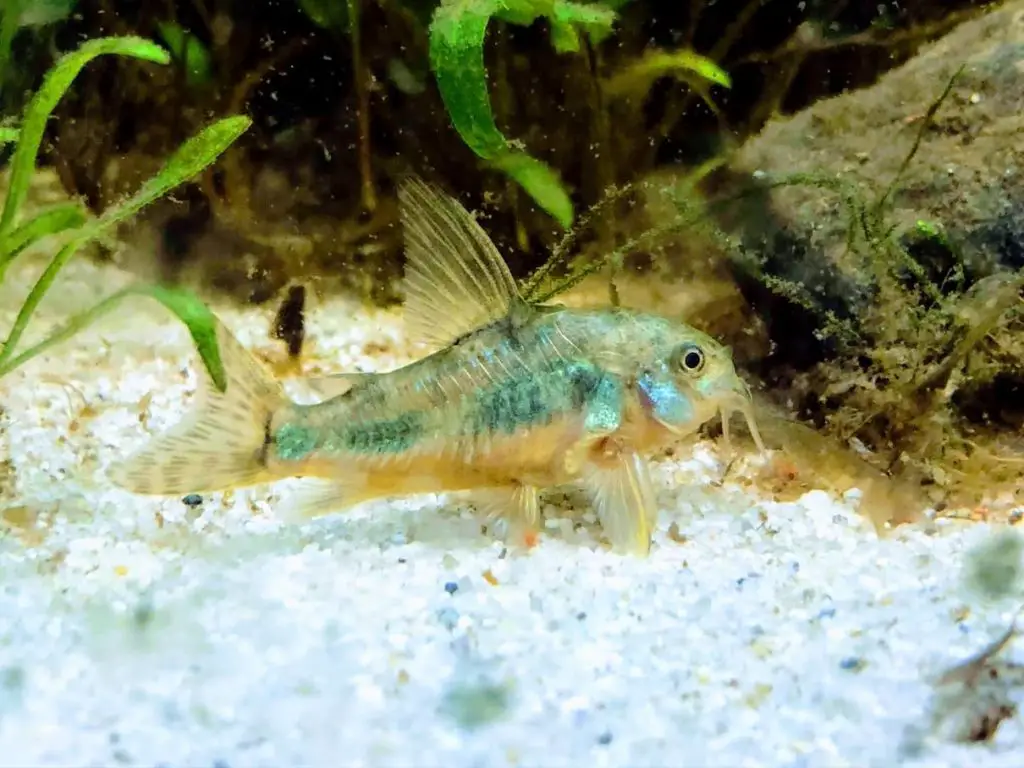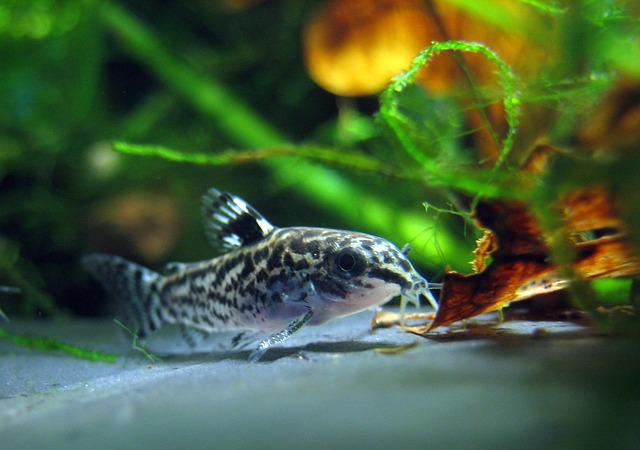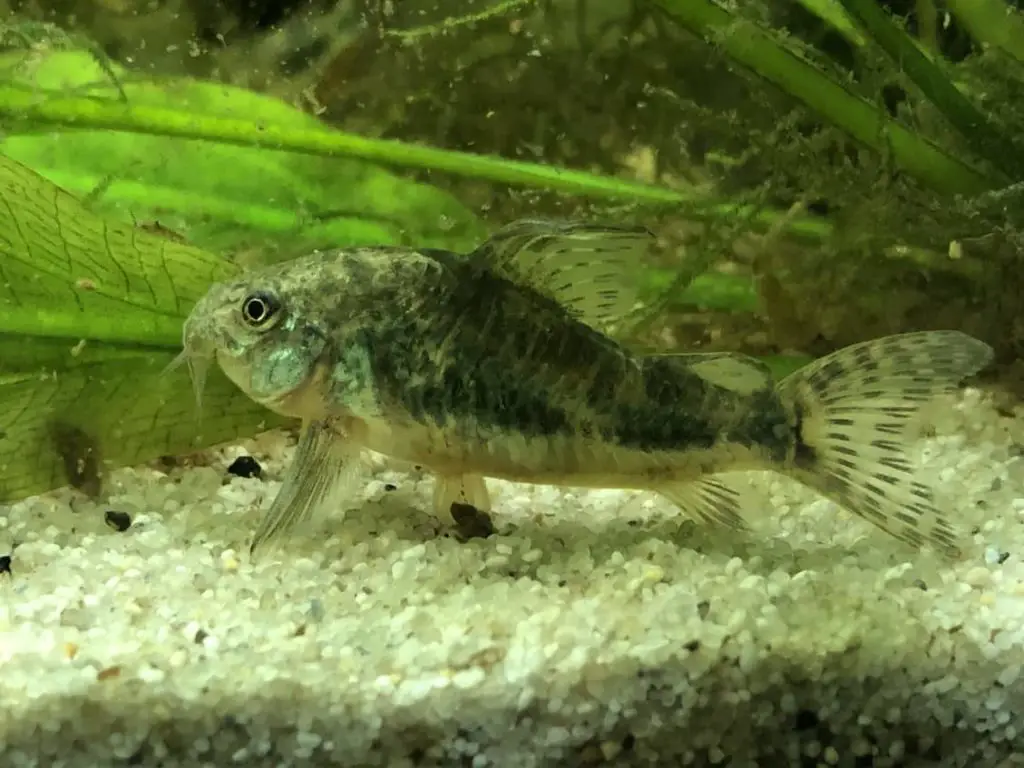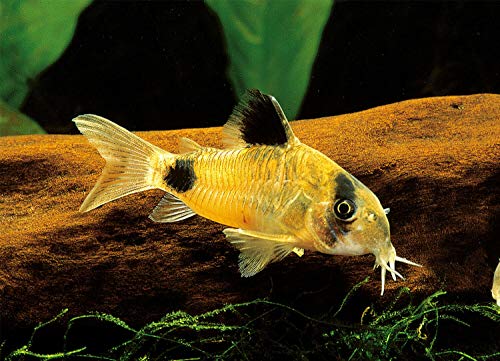Cory catfish are small, schooling fish that make a great addition to a small tank. They are peaceful and like to be in groups. Corys will scavenge the bottom of the tank for food and can live peacefully with most other fish. They do best in a tank with sand or fine gravel substrate and plenty of plants.
You can keep between 2 and 4 cory catfish in a 10-gallon tank, depending on the size of the fish. These small to medium-sized bottom-dwelling scavenger freshwater fish should never be kept alone as they like to swim in schools with fellow cory catfish.
A 10-gallon tank makes a great starting point for new fish hobbyists or those who don’t have much space but be careful not to overcrowd it.
How Big Do Cory Catfish Get, and How Long Do They Live?
Cory catfish, Corydoras catfish, cory cats, or cory fish make great additions to a community tank.
Depending on the type of cory catfish, these popular fish are usually between 1 and 3 inches long, and the tiny Pygmy cory only reaches ¾ inches at even at maturity.
If you’re a bit tight on space, you can look for Pygmy catfish at your nearby pet stores to ensure that they have enough room in the tank.
Different types of cory catfish have different lifespans, but they generally live for about 5-10 years in a well-balanced tank environment.

How Many Cory Catfish Can You Keep Together?
Cory catfish are pretty small compared to other fish in their native habitat in South America. They have learned that safety is in numbers, and in the wild, they shoal in groups as small as 20 right up to shoals containing hundreds of fish. Even in a safe aquarium environment, you will find that they are community fish and like to school together.
The happiest tanks of cory catfish are usually in groups of 6 or more, depending on the size of the tank and the other fish present.
Even if you haven’t got space for that many cory fish, you should always have at least 2 in your tank. You’ll be able to watch them sticking close together while feeding and resting. People keep a single cory catfish, but it’s not uncommon for these fish to die of loneliness.
No matter how many fish you have, remember that any other life in your tank will change the bio-load ratio, so make sure you’re keeping it nice and balanced.

Is a 10-Gallon Tank the Best Size for Cory Catfish?
A general rule of thumb for fish keeping is to allow 1 gallon of water for one fish. Remember- this rule is flexible depending on the size of the fish. Many of the more popular breeds of cory catfish grow up to 2.5-3 inches long, making 10-gallons the minimum sized tank for cory catfish.
If you’re starting with fishkeeping or tight on space, there’s nothing wrong with a 10-gallon tank if you stock it responsibly.
If you want more cory fish in your 10-gallon tank, try to find some Pygmy cory fish. They are so tiny that you could have ten dwarfs in a 10-gallon tank without space for other fish varieties. Make sure you work out what you want before stocking your tank.
What Kind of Tank Do Cory Catfish Need?
Cory catfish need a completely covered tank because they dart up to the surface for a gulp of air or to snatch some food. A secure tank lid stops them from accidentally leaping out onto the floor.
Depending on the species, cory catfish live in freshwater at temperatures between 72 – 82oF with pH levels between 6.5 and 7.8 and do great with standard tank lighting.
Because they are bottom dwellers, you should keep at least 2 inches of non-abrasive substrate or sand on the floor of your tank and plenty of live plants to provide oxygen and hiding places for your fish.
Make sure you stay on top of ammonia and nitrate levels with regular partial water changes and be careful not to stir up the substrate to keep your water nice and clear.
How Many Types of Cory Catfish Are There?
There are many different types of cory catfish with over 160 identified varieties and many hundreds more which haven’t been officially classified yet.
Here’s a list of the most common types of pet cory catfish:
- Bandit Cory, these black and white fish are sensitive to temperature changes so take care!
- Bronze cory, these colorful varieties can be bronze, green, black, and even albino.
- Panda cory, these fun cory catfish thrive in completely unheated aquariums.
- Pepper Cory is one of the most common and largest pet cory catfish, so they need a larger tank.
- Skunk cory only introduces these to established tanks as they are sensitive to water quality.
- Three Stripe cory, these fish have a beautiful and unique maze-like pattern.
- Julii cory, these are similar to the Three-Stripe, but with separate dots across their bodies.
- Pygmy cory, these tiny cory catfish require fine and non-abrasive sand and lots of plants.
Can You Keep Different Types of Cory Catfish in The Same Tank?
Yes, you certainly can! Cory catfish are incredibly social fish and will live happily alongside different types of cory. But you should keep in mind that they only like to shoal with the same kind of cory fish, so make sure you have at least 2 of each cory catfish in your tank.

What Kinds of Fish Can Live with Cory Catfish?
Most small to medium-sized community fish make excellent tankmates for cory catfish. Just check that these other fish are friendly and non-aggressive.
Other than different types of cory, fish that make a good community with cory catfish include tetras and swordtails and filter-feeding or fan-feeding shrimp. You can even add freshwater snails like Gold Inca or Ramshorn snails to help keep your tank in tip-top shape.
Avoid aquarium crayfish and fish from the cichlid family, which tends to be quite territorial and may even eat your cory catfish.


